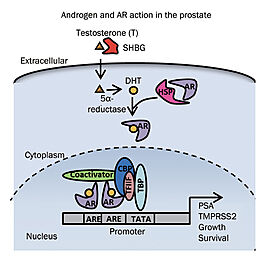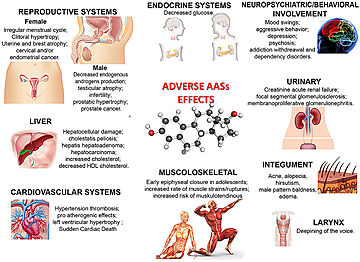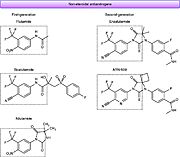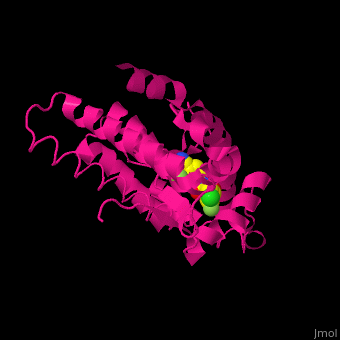The androgen receptor (AR) belongs to the steroid hormone group nuclear receptor family together with the estrogen, progesterone, glucocorticoid and mineralcorticoid receptor.
AR mediates the actions of testosterone (T) and a more biologically active form, 5α-dihydrotestosterone (DHT), which are the male sex hormones required for development of the male reproductive system and secondary sexual characteristics. This receptor, located on the X chromosome, has significant biological actions in many systems, because it is expressed in a diverse range of tissues [1]. Other androgens that bind with much less potency than T and DHT are androstenedione, androstenediol, and dehydroepiandrosterone (DHEA) [2].
See also Androgens, Steroid Hormones and their receptors and Intracellular receptors
Structure
Similar to other members of the nuclear receptor family, the AR consists of three main functional domains which aid in controlling and regulating transcriptional activity.
Domains
N-terminal Domain (NTD)(residues 1-555)
This region is required for full transcriptional activity [3] because of its necessary presence for Ligand-Binding Domain (LBD) activation [4]. The sequence and lengths of the polyglutamine (CAG) and polyglycine (GGC) repeats are highly variable in the human population, making this the most variable domain. It has been shown that the length of the CAG repeat region affects folding and structure of this domain. Shorter repeats generally impose a higher AR transactivation activity, whereas longer repeats cause reduced activity [3]. In healthy people, one region of the AR gene shows up to 36 repeats of the CAG sequence. Patients with abnormally high numbers of CAG repeats can develop spinal muscular atrophy.
DNA-Binding Domain (DBD) (residues 555-623)
DBD is a cysteine-rich region that is the most highly conserved one in the steroid hormone nuclear receptor family [3]. It has been shown that binding of this region to selective androgen response elements (AREs) allow the specific activation functions of the AR. AREs facilitate direct DNA binding of the AR to the promoter and enhancer regions of AR-regulated genes, thereby allowing the activation functions of the N-terminal and LBD to stimulate or repress transcription of these genes [1].
AR dimeric structure, like that of other steroid receptors, consists of two equal, common hexameric half-sites, separated by a 3 base-pair spacer [3]. This domain is critical for AR function, due to its role in dimerization and binding of dimerized AR to select motifs on target DNA [4].
Each DBD monomer has a core composed of two zinc finger motifs, which consist of four cysteine residues that coordinate a zinc ion [3]. The first one is closer to the NTD which has the P box, identical in all family members, that controls the DNA binding specificity at AREs [4]. The second zinc finger motif facilitates AR dimerization via the D box.
Additionally, a nuclear localisation signal (NLS) lies at the junction between the DBD and the hinge region. This NLS binds to importin-α and facilitates nuclear translocation [4]. Passive transport across the nuclear pore complex has been suggested ranging from 20–40 kDa; in contrast, the AR, which is 110 kDa in size, requires importins to be actively transported upon ligand binding [3].
The DBD is linked to the LBD by a flexible hinge region (residues 623-665), which is a poorly conserved linker. Once in the nucleus, this region also interacts with the DBD to identify specific sequences for AR binding. It controls the AR activation and degradation. Consequently, mutations in the hinge region can lead to enhanced AR potency [4].
Ligand-Binding Domain (LBD) (residues 665-919)
The LBD, located at the C-terminus, is the main target of AR inhibitors [4]. It consists of eleven α-helices in the ligand binding pocket ( ) , wich reposition upon androgen binding, converting this domain into an activation function 2 (AF-2) domain. Unlike other nuclear receptors, the AR does not have Helix 2, which is instead replaced by a long flexible linker [3]. The LBD binds to motifs in the NTD and in AR-specific cofactors and coactivators. Moreover, LBD-LBD homodimerization of AR is essential for the proper functioning of the receptors [4].
This domain has been structurally well characterized by crystallography and a number of mutations have been identified. It is important because not all mutations affect ligand binding, but some of them may disrupt androgen-induced interactions of the N-terminal motif and C-terminal AF-2 [4].
Transcriptional Activation Function
Two transcriptional activation functions have been identified:
- The ligand-independent AF-1 domain (residues 142-485) is the main region responsible for mediating AR transcription. It is located in the NTD and it contains two independent transcription activation units that are indispensable for full activity of the AR [3].
- The ligand-dependent AF-2 is located in the LBD [1]. forms the core of this region and acts as a lid to close the LBD upon agonist binding [3]. It is important for forming the coregulator bindings site as well as mediating direct interactions between the N-terminal and LBD. Key differences in the contribution of specific conserved residues in the AF-2 core domain between the AR and other steroid hormone nuclear receptors have been identified, it would explain the differences in the structure and the function, as well as the coregulatory proteins they interact with [1].
Mechanism of Action
AR signaling
AR has two mechanisms of action: the DNA binding-dependent (genomic AR signaling) and the DNA binding independent (non-genomic AR signaling).

Reproduced from Davey & Grossmann.
[1] DNA-Binding dependent actions of the AR

Reproduced from Tan et al.
[3]In the absence of ligand, the AR is in the cytoplasm and associated with heat-shock and other chaperone proteins. Testosterone is converted into DHT by 5α-reductase, with higher affinity to bind the receptor. When DHT binds AR, it displaces heat shock proteins, drives the interaction between the N- and C-terminal, and binds importin-α to translocate the ligand/AR complex into the nucleus.
In the nucleus, the receptor dimerizes and binds to AREs in the promoter regions of target genes. At the promoter, the AR is able to recruit members of the basal transcription machinery in addition to other coregulators to facilitate transcription [3].
AR activity is not only regulated by ligand binding and DNA binding but also by intramolecular interactions between functional domains, by homodimerization and by interactions with cofactors [5].
This leads to the initiation of transcription, cell proliferation and survival, and negative feedback to inactivate AR transcription [1].
Non-DNA Binding dependent actions of the AR
It has been shown that the androgen/AR complex activates 2nd messenger pathways including ERK, Akt and MAPK, and it also interferes with several key proteins including forkhead box protein A1 (FOXA1), PI3K and receptor tyrosine kinases. These effects occur within seconds to minutes of androgen treatment [1][6].
Several studies suggest that some of the non-DNA binding-dependent actions of androgens are mediated via the activation of membrane-bound protein receptors. For instance, the iron-regulated transporter-like protein 9 (ZIP9) mediates the androgen-induced apoptosis of ovarian follicle cells, prostate and breast cancer cells [1].
Although the physiological significance of the non-DNA binding-dependent actions of the AR is not yet fully defined, it has been proposed they may oppose the DNA binding-dependent actions and serve as a brake to fine-tune androgen action in target tissues [1].
Ligand-Independent actions of the AR
It has been demonstrated that AR has the potential to be activated through ligand-independent mechanisms by a number of different growth factors, via phosphorylation of the AR or following interaction with co-activators [1].
Function
As AR is expressed in many tissues, androgens have been documented to have significant biological actions in bone, muscle, prostate, ovaries, endometrium, bladder, skin, cardiovascular, immune, neural and hematopoietic systems [1][7].
Androgens have a role in behavior and cognition in neuronal cells in the CNS [7]. It has also been shown they regulate hair growth, sebum production and secretion, wound healing and cutaneous barrier formation in the skin [8].
The absence of AR has an impact on the fertility in granulosa cells in the ovary and it also affects the myometrial cell growth in uterine glandular epithelial cells in the endometrium [7].
Diseases
Drugs targeting the AR has the potential to be used in prostate cancer, benign prostatic hyperplasia (BPH), osteoporosis, breast cancer, hypogonadism, conditions where cachexia is a consequence of the disease state (HIV, cancer, immobilization), urinary incontinence, muscle wasting conditions as Duchenne muscular dystrophy (DMD) and Alzheimer’s disease [9][10][11][12].
Prostate Cancer
AR is fundamental for the correct function and development of the prostate [13], having a critical role in the control of homeostasis between prostate cells differentiation and proliferation [14]. It's widely accepted this receptor plays an important role in prostate cancer cells due to the alteration of that equilibrium, shifting the AR to a more proliferative transcriptional program [14].
Alzheimer’s Disease
Androgen depletion is considered a significant risk factor for Alzheimer’s disease, and circulating testosterone levels are inversely correlated with levels of ß-amyloid (ßA) in the brains of aged men [9].
Pharmacology
Steroidal Drugs
Natural ligand: Testosterone
Aging and other factors are associated with a reduction of testosterone levels which could lead to late onset hypogonadism [15]. The decrease of the T levels and therefore its active metabolite levels (DHT) are related with several symptoms such as low libido, erectile dysfunction, skeletal muscular loss [10][15], increased cardiovascular risk [15], etc. Testosterone Restitution Therapy (TRT) is recommended to treat those symptoms, and has been associated with the improvement in sexual function and the increase in muscle mass and bone mineral density [16].
One of the problems associated with the use of testosterone as a therapeutic agent in TRT is the delivery method, tending to have low efficacy when it is administered orally [10][11]. It also has some disadvantages when administered by intramuscular injections or implants [10]. Also, the use of this hormone as a treatment could triggered a lot of AR activity widespread around the body. Long-term exposures to a high dose could lead to related side effects like erythrocytosis [10][11], dyslipidemia, hepatotoxicity [11] and an increase in cardiovascular risk [15][16].
Due to all these problems, some institutions like the FDA warn about the safety issues related with this therapy assessing the reduction of its use [15][16]. However, other agencies like the EMA supported by the European Academy of Andrology establish the practical use of this therapy in men’s hypogonadism [15][16]. So, there is still some controversy about its use, and it is currently studied in clinical trials [16].
(2ylo).
Antagonist: Steroid Androgen Receptor Antagonist (ARA)
The development of these drugs was one of the first approaches to treat prostate cancer, targeting AR activity by having a pharmocological structure with a steroidal skeleton [14].
This kind of antiandrogens have affinity to other steroid receptors (glucocorticoids receptor, progesterone receptor…), show low efficacy and cause some side effects like hepatotoxicity and increased cardiovascular risks [14]. Some examples are cyproterone acetate (CPA) [14][17][18] or megestrol acetate [14].
Agonist: Anabolic Androgen Steroids (AAs)

Reproduced from Sessa et al.
[19]These types of drugs began to be produced in mid-20th century [20]. They have anabolic activity what improves muscular mass and physical function. However, their uncontrolled use and abuse lead to several side effects like testicular atrophy, alopecia, gynecomastia in the case of males, and clitoral hypertrophy or menstrual irregularities in the case of women. Men and women can experience mood disorders and the chronic abuse could result in a high risk of suffering cardiovascular disease and prostate cancer [20].
Because of the doping scandals in the athlete community, the World Anti-Doping Agency (WADA) has banned them [20]. This creates the need to discover androgens that have beneficial anabolic activity with reduced androgenic activity.
Non-Steroidal Drugs
Selective Androgen Receptor Modulators (SARMs)
Steroid androgens can be associated with a high rate of adverse effects, which limits their widespread clinical use. SARMs were developed to try to overcome these side effects.
SARMs are small molecule drugs that manipulate AR function in different tissues [9], acting as both agonist and antagonist, with potential to treat AR-related diseases.
These non-steroidal drugs can normally be administered orally or using a transdermal injection [10][11] with better compliance. They are not affected by 5α-reductase (limiting their androgenic adverse effects) and aromatase (limiting their estrogenic side effects) [10][11]. Those characteristics help to reduce side effects related to the use of natural androgens. Moreover, the tissue selectivity of these drugs make them a suitable option to treat syndromes and diseases skipping the risk related with the use of TRT [10][11][12].
Also, some SARMs could be a good option to achieve the improvement in anabolic activity and muscular density obtained by the use of AAs, without the unwanted side effects associated with their androgenic action [20].
Characteristics of SARMs
Currently, the tissue selectivity of SARMs is still under research [12][20] and there is no consensus in the detailed mechanisms of action. However, there are two features that could explain their biological activity:
- Their non-steroidal composition and the fact that they are unaffected by 5α-reductase [11][12][20], promotes the interaction of AR with tissue-specific coactivators.
- The way SARMs bind to the AR, which is what primarily enhances or represses their effect. Each SARMs/AR complex has a different conformation and tissues have unique patterns of AR expression, co-regulatory proteins levels and transcriptional regulation [9].
When a ligand promotes interactions between the N- and C-terminal AR domains, the AR is fully active. The ability to reduce N/C interactions is the hallmark of SARMs that display antagonisms in androgenic tissues [9].
Diseases that could be treated with SARMs
SARMs may one day play a role in the treatment of cognitive disorders, such as Alzheimer's disease. Androgens facilitate the reduction of deleterious ß-amyloid (ßA) plaques, upregulating the expression of ßA-degrading neprilysin and promoting synapse formation and neurogenesis, upregulating brain derived neurotrophic factor [20].
AR in breast cancer likely confers survival advantage by modulating ER signaling, which may reduce the risk of metastasis and aggressive disease. There is a clinical trial seeking to evaluate pembrolizumab and enobosarm co-therapy for the treatment of AR positive metastatic triple negative breast cancer [9].
Urinary incontinence denotes involuntary bladder urine leakage amongst women commonly with decreased pelvic muscle strength. As the pelvic floor muscles contain high levels of AR, it is a relevant target for SARM therapy [20].
Side effects of SARMs
Despite the consistent effect demonstrated by SARMs on lean body mass accrual, reductions in high-density lipoprotein (HDL) seem to be an important concern with these compounds, although it occurs to a lesser extent compared to testosterone [21].
SARMs administration has also been related to hepatotoxicity and some compounds have been linked to alterations in liver enzymes. The most common adverse events are an increase in alanine transaminase and aspartate transaminase [21].
The anabolic effects of SARMs and their lack of androgenic side effects have made them of great interest to the bodybuilding community and create the potential for abuse among competitive athletes [9].
Antagonist

Reproduced from Helsen et al.
[14]These kinds of drugs were developed with the objective to avoid the side effects associated with cross reactivity of steroidal ARA, increasing the selectivity and the affinity to the AR, limiting the association with other steroids nuclear receptors [17]. Also, their non-steroidal structure improved oral bioavailability what constitutes another advantage in comparison with steroidal ARA [17]. Some examples are flutamide, bicalutamide [14][17][18][22][23][24] or apalutamide (ARN-509) [14][24].
Bicalutamide
, marketed as Casodex [14][18], is one of the most stable and tolerated ARA used in the treatment of prostate cancer [14][17][25], belonging to the first generation of antiandrogens developed [14][26].
It is a competitive antagonist [22][26][25] which binds to the LBD producing a transcriptionally inactive AR [22]. However, it seems that the long-term use of these drugs and other first generation antiandrogens lead to withdrawal syndrome in prostate cancer resistant to castration patients [14][18]. In many cases, associated AR mutations, like W741L, can switch the mechanism of action of the drug from antagonist to agonist or partial agonist [14][17][18][23][26].
Although bicalutamide has been patented since 1982 and approved to be clinical used by the FDA since 1995 [17], its mechanism of action is still under debate. The X-ray structure of the wild-type AR bound to an antagonist is not yet solved [26]. Changes in the conformation of the receptor, due to association with antagonists, have been hypothesized to be similar to those produced in the steroid receptor family [14][26].
When an agonist or a ligand binds to the LBD, it seems to induce a conformation of the steroid receptor which makes H12 closes off the pocket of LBD allowing the binding of cofactors. That permits the steroid receptor function allowing the DNA transcription [14].
Although, when an antagonist is bound, H12 seems to be more separated from the LBD, disabling the binding of coactivators [14] and the migration of the nuclear receptor into the nucleus [26].
Nonetheless, the AR has some structural singularities that may not let this change of conformation. One of the most important changes is the additional C-terminal region in H12 anchored to the receptor by the formation of a ß-sheet, limiting its movement [14][26]. Due to this structural difference, in silico approaches have suggested that the antiandrogen effect of bicalutamide may be produced by the instability of the homodimer [26]. That may lend to the dissociation of the homodimer preventing the transcriptional activity of the AR and explaining the mechanism of action of this drug [26]. In addition, in silico analysis have shown that the W741L mutation leads to a more stable bicalutamide-AR homodimer, which may provide some insight into the withdrawal syndrome observed in bicalutamide treatment [26].
For future research, it will be useful to understand the precise mechanism of action of antiandrogens currently used in the clinic, with the objective of developing new drugs which can escape from the antagonist-agonist switch seen in bicalutamide or flutamide. One example of this is apalutamide, a non-steroidal second generation antiandrogen [14][24], approved for use in non metastatic castration resistant prostate cancer patients by the FDA in 2018 [24]. See also the SPARTAN study[27]. This new drug has promising uses but it is still associated with side effects like an increased level of falls in patients with the treatment vs placebo [28].
3D Structures of androgen receptor
Androgen receptor 3D structures
See Also





